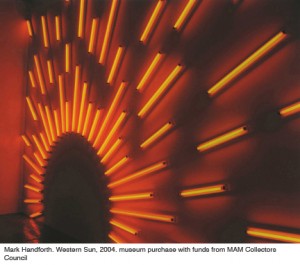« Reviews
Disappearances, Shadows and Illusions: A Challenge to the Senses
 Miami Art Museum
Miami Art Museum
June 6th - September 21st, 2008
Over the summer Miami Art Museum hosted “Disappearances, Shadows and Illusions,” an exhibition curated by Peter Boswell, which made one reflect on the relative and at the same time deceptive nature of human perception, and challenged the visitor to actively participate in his role as observer.
Participating artists, many of them residents of Miami, presented pieces, which through manipulation of lights, perspectives or meanings, instantaneously alluded to ideas such as impermanence and doubt. The pieces required the spectator to construct his own interpretation of the artistic phenomenon in question. This type of manipulation was somewhat paradoxical, taking into consideration that the exhibition took place in a museum, an institution traditionally associated symbolically with absolute knowledge and immutable truth. This exhibition, however, questioned the aura of sanctity surrounding a museum, and proposed a much more dynamic interpretation of and interaction with the works of art.
“Western Sun” by Mark Handforth stood out amongst the pieces that challenged the senses. An enormous sun, created using fluorescent bulbs, emerged from the floor and flooded the space with a fierce red light, a light that awakened a sensation of heat, which appeared to grow stronger as the individual drew ever closer. The oeuvre placed before our eyes everyday objects, with known specific functions as in the case of light bulbs, but presented them from a completely different perspective.
For his part, the Miami-based artist, COOPER, presented an installation that demonstrated the relative, doubtful and at times elusive nature of history. “Drainpipes and death myth…” reflected on how temporal distance can generate a new discourse relative to historic events. COOPER structured his work around the figure of Abraham Lincoln. In a video, which he placed within an enormous wooden cone suspended from the ceiling, the artist created a scenario which never took place in the life of this personage. The artist, with this piece, questions historical truths, which are susceptible to being manipulated from the present. Various objects, arranged in a manner similar to traditional museums’ “historic environments,” completed the installation, creating the misleading sensation that they were evidence of Lincoln’s life.
Other works, such as “Cortinas de baño” (Bathroom Curtains) by the Colombian, Oscar Muñoz, referred to how the decisive influence of social context can make even the most inhospitable situations seem mundane. Inspired by the wave of violence shaking his country, bathroom curtains, which distort macabre silhouettes of human beings, allude to how death and disappearances can become as quotidian and familiar as taking a shower.
The artist, Elizabeth Cerejido, with her series “Absence,” addressed the fleeting nature of human memory. A video showed her mother, lost in the endless labyrinth of Alzheimer’s, a labyrinth in which daily routines become strange, and objects distort their functions and even their spatial location, plunging the subject into a kind of abyss in which the prevailing feeling is immense panic in the face of the unknown.
The pieces assembled in “Disappearances, Shadows and Illusions” lead us to accept that our visual experience before a work of art is not so much an affirmation of our existing values, but rather a purifying ritual, refreshing our eyes, mind and spirit, inclining us to view the world in a new light.
Filed Under: Reviews


































